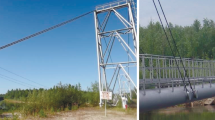Formulation of a method for the strength design of a rubber cable stay with defects in its connection to a structure. Solving the model of interaction of discrete cables joined by rubber, taking into account the break in the continuity of the cables in the stay connection assembly and the nonlinearity of deformation of stay components. A method for the strength design of a rubber cable stay with a connection defect under the nonlinear deformation of its components. The stay in the structure is subjected to significant loads. It is mostly composed of a system of parallel pulling elements. These can be cables. In general, there can be several defects in the connection, but less than the number of cables. A defect in the connection of the stay to the structure is manifested in the redistribution of forces between the reinforcement elements – cables. A cable connection defect is considered to be a connection for which the cable load is zero (the maximum possible consequence of a single defect). A method for determining the stress-strain state of a stay rope with defects at which the loads of several cables in the connection cross-section are equal to zero. A break in the continuity of a stay cable significantly affects the stress state of adjacent cables and the material, interacting with it, over a limited length. The number of cables adjacent to the damaged ones affects the level of stress increase. At a smaller number, the stresses increase more. The nonlinear nature of the ratio of the shear modulus of the matrix material and the tensile elastic modulus of the cables practically does not affect the size of the zone of perturbation of the cable’s stress state in the event of a break in cable continuity. The method allows taking into account the effect of the maximum deviation of the load force of an arbitrary cable from the design one on the pulling capacity of the stay due to a defect in the connection to the structure, taking into account the nonlinear deformation of its components, thereby increasing the reliability of the results of stay calculation and thereby increasing the reliability of the structure.


Similar content being viewed by others
References
Ya. A. Balabukh, “Efficiency of steel-reinforced concrete road bridges,” Dorohy i Mosty, Issue 12, 16–23 (2010).
L. P. Bodnar, P. M. Koval, S. M. Stepanov, and L. G. Panibratets, “Operational condition of bridges in Ukraine,” Avtoshlyakhovyk Ukrainy, No. 2, 57–67 (2019). https://doi.org/10.33868/0365-8392-2019-2-258-57-68
I. Belmas and D. Kolosov, “The stress-strain state of the stepped rubber-rope cable in bobbin of winding,” in: Technical and Geoinformational Systems in Mining, Taylor & Francis Group, London, UK (2011), pp. 211–214.
J. R. Cho, Y. H. Yoon, C. W. Seo, and Y. G. Kim, “Fatigue life assessment of fabric braided composite rubber hose in complicated large deformation cyclic motion,” Finite Elem Anal Des, 100, 65–76 (2015).
P. P. Lepikhin and V. A. Romashchenko, “Methods and findings of stress-strain state and strength analyses of multilayer thick-walled anisotropic cylinders under dynamic loading (review). Part 3. Phenomenological strength criteria,” Strength Mater, 45, No. 3, 271–283 (2013). https://doi.org/10.1007/s11223-013-9456-z
S.-B. Kwak and N.-S. Choi, “Micro-damage formation of a rubber hose assembly for automotive hydraulic brakes under a durability test,” Eng Fail Anal, 16, 1262–1269 (2009).
H. I. Tantsura, Flexible Traction Elements. Butt Joints of Conveyor Belts [in Ukrainian], DDTU, Dniprodzerzhynsk (2010).
I. Belmas, D. Kolosov, O. Kolosov, and S. Onyshchenko, “Stress-strain state of a conveyor belt with cables of different rigidity and their breakages,” Fundamental and Applied Researches in Practice of Leading Scientific Schools, 26, 231–236 (2018).
I. Belmas, O. Bilous, H. Tantsura, et al., “The effect of cable break on the stress state of a rubber cable stay rope,” in: Computer-Integrated Technologies: Education, Science, Production [in Ukrainian], Issue 48 (2022), pp. 42–52.
I. Belmas, D. Kolosov, S. Onyshchenko, et al., “Influence of nonlinear shear modulus change of elastomeric shell of a composite tractive element with a damaged structure on its stress state,” Inżynieria Mineralna, J Polish Mineral Eng Society, 51, No. 1, 155–162 (2023). https://doi.org/10.29227/IM-2023-01-18
Author information
Authors and Affiliations
Corresponding author
Additional information
Translated from Problemy Mitsnosti, No. 4, pp. 66 – 73, July – August, 2023.
Rights and permissions
Springer Nature or its licensor (e.g. a society or other partner) holds exclusive rights to this article under a publishing agreement with the author(s) or other rightsholder(s); author self-archiving of the accepted manuscript version of this article is solely governed by the terms of such publishing agreement and applicable law.
About this article
Cite this article
Belmas, I.V., Bilous, O.I., Tantsura, H.I. et al. Strength of a Rubber Cable Stay with Defects in its Connection to a Structure. Strength Mater 55, 736–742 (2023). https://doi.org/10.1007/s11223-023-00563-y
Received:
Published:
Issue Date:
DOI: https://doi.org/10.1007/s11223-023-00563-y



